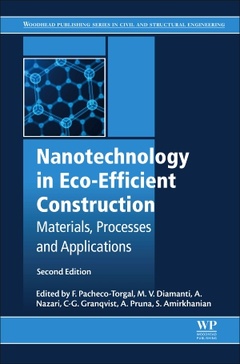Nanotechnology in Eco-efficient Construction (2nd Ed.) Materials, Processes and Applications Woodhead Publishing Series in Civil and Structural Engineering Series
Coordonnateurs : Pacheco-Torgal Fernando, Diamanti Maria Vittoria, Nazari Ali, Goran-Granqvist Claes, Pruna Alina, Amirkhanian Serji

Covering the latest technologies, Nanotechnology in eco-efficient construction provides an authoritative guide to the role of nanotechnology in the development of eco-efficient construction materials and sustainable construction. The book contains a special focus on applications concerning concrete and cement, as nanotechnology is driving significant development in concrete technologies. The new edition has 14 new chapters, including 3 new parts: Mortars and concrete related applications; Applications for pavements and other structural materials; and Toxicity, safety handling and environmental impacts.
Civil engineers requiring an understanding of eco-efficient construction materials, as well as researchers and architects within any field of nanotechnology, eco-efficient materials or the construction industry will find this updated reference to be highly valuable.
1. Introduction to nanotechnology in eco-ef?cient construction F. Pacheco-Torgal
Part 1. Mortars and concrete related applications 2. In?uence of nanoparticles on the strength of ultra-high performance concrete Ksenija Jankovic, Dragan Bojovic and Marko Stojanovic3. The effect of nanoparticles on the self-healing capacity of high performance concrete J.L. García Calvo, G. Pérez, P. Carballosa, E. Erkizia, J.J. Gaitero and A. Guerrero4. The impact of graphene oxide on cementitious composites Alyaa Mohammed, Jay G. Sanjayan, Ali Nazari and Nihad T.K. Al-Saadi5. Application of nanomaterials in alkali-activated materials Q.L. Yu6. Effects of nano?bers on properties of geopolymer composites Akm Samsur Rahman7. Nanoindentation for evaluation of properties of cement hydration products Saptarshi Sasmal and M.B. Anoop
Part 2. Applications for pavements and other infrastructure materials8. Performance of asphalt mixture with nanoparticles Shaban Ali Zangena9. Nanomodi?ed asphalt mixture with enhanced performance Shuaicheng Guo, Xu Yang, Zigeng Wang, Lingyun You, Qingli Dai and Zhanping You10. Effects of graphene oxide on asphalt binders Yuanyuan Li, Shaopeng Wu and Serji Amirkhanian11. NanoComposites for structural health monitoring Qiaofeng Zheng, Baoguo Han and Jinping Ou12. Concrete with nanomaterials and ?bers for self-monitoring of strain and cracking subjected to ?exure Yining Ding, Genjin Liu, Zhibo Han, F. Pacheco-Torgal and Antonio Augusto Veloso de Costa13. Icephobic nanocoatings for infrastructure protection Zaid Ayaz Janjua14. Self-healing nanocoatings for protection against steel corrosion Alicja Stankiewicz15. Nanocoatings for protection against steel corrosion A. Pruna16. Fire retardant nanocoating for wood protection L.N. Vakhitova
Part 3. Applications for building energy ef?ciency17. Aerogel-enhanced insulation for building applications U. Berardi18. Nano aerogel windows and glazing units for buildings’ energy ef?ciency Muhammad Abdul Mujeebu19. Smart perovskite-based technologies for building integration: a cross-disciplinary approach Alessandro Cannavale and Francesco Martellotta20. Electrochromic glazing for energy ef?cient buildings Claes Goran Granqvis21. VO2-based thermochromic materials and applications: ?exible foils and coated glass for energy building ef?ciency Xun Cao, Ping Jin and Hongjie Luo
Part 4. Photocatalytic applications 22. Photocatalytic performance of mortars with nanoparticles exposed to the urban environment Maria Vittoria Diamanti and MariaPia Pedeferri23. Multifunctional photocatalytic coatings for construction materials Marisol Faraldos and Ana Bahamonde24. Self-cleaning ef?ciency of nanoparticles applied on facade bricks Magdalena Janus and Kamila Zajac25. Nanotreatments to inhibit microalgal fouling on building stone surfaces Giovanni Battista Goffredo, Stefano Accoroni and Cecilia Totti26. Self-cleaning cool paints Hideki Takebayashi27. Photocatalytic water treatment Lev Matoh, Bostjan Zener, Romana Cerc Koro_x0003_sec and Urska Lavrencic Stangar
Part 5.Toxicity, safety handling and environmental Impacts28. Toxicity of nanoparticles Cristina Buzea and Ivan Pacheco29. Risk management: controlling occupational exposure to nanoparticles in construction F. Silva, P. Arezes and P. Swuste30. Measurement techniques of exposure to nanomaterials in workplaces Riccardo Ferrante, Fabio Boccuni, Francesca Tombolini and Sergio Iavicoli31. Life-cycle assessment of engineered nanomaterials Stefano Cucurachi and Carlos Felipe Blanco Rocha
Researchers in academia and industry with an interest in nano-technology and construction, and other fields including Civil Engineering, Nanomaterials, Applied Chemistry, Structural Engineering
Dr. F. Pacheco-Torgal is a principal investigator at the University of Minho, in Portugal. He currently holds the title of Counsellor from the Portuguese Engineers Association and has authored more than 300 publications. He is a member of the editorial boards for 9 international journals. He has acted as a foreign expert in the evaluation of 30 PhD theses. In the last 10 years he has been a Member of the Scientific Committee for almost 60 conferences most of them in Asian countries. He is also a grant assessor for several scientific institutions in 15 countries including the UK, US, Netherlands, China, France, Australia, Kazakhstan, Belgium, Spain, Czech Republic, Chile, Saudi Arabia, UA. Emirates, Croatia, Poland, and the EU Commission. He has also been an invited reviewer for 125 international journals and has reviewed almost 1200 papers and has been the lead editor of 27 books.
Maria Vittoria Diamanti is an Assistant Professor in the Department of Chemistry, Materials and Chemical Engineering at the Polytechnic of Milan, Italy. Her current research interests are: titanium oxides, nanostructured surfaces, photocatalysis, self-cleaning surfaces, spectrophotometry and reflectometry, corrosion, and durability of reinforced concrete.
Ali Nazari is a Postdoctoral research Fellow at Centre for Sustainable Infrastructure, Faculty of Science, Engineering and Technology, Swinburne University of Technology, Victoria, 3122, Australia
Claes Goran-Granqvist is Professor in the Department of Engineering Science at Uppsala University, Sweden. Professor Granqvist's research is focused on optical and electrical properties of materials, especially thin films for energy efficiency and solar energy utilization. He has published around 730 research papers in mostly refereed journals, over 30 books, had invited conference presentations at about 250 international conferences and chaired about 30 international meetings.
A. Pruna is a Scientific Researcher in t
- Addresses issues such as toxicity and LCA aspects
- New chapters covering safety handling on occupational exposure of nanoparticles and the assessment of personal exposure to airborne nanomaterials
- Discusses the effects of adding nano-particles on the durability and on the properties of geopolymers
Date de parution : 11-2018
Ouvrage de 896 p.
15x22.8 cm
Thème de Nanotechnology in Eco-efficient Construction :
Mots-clés :
Nanotechnology; eco-efficiency; built environment; LCA; concrete; energy-efficiency; photocatalysis



